
Revised and Updated December 2022.
Most visitors to Hoi An Vietnam, divide their time between three main activities. Day Trips, the beach – especially An Bang and Cua Dai Beaches – and the Old Town.
Hoi An Old Town or Hoi An Ancient Town, as it is often called, is the most prominent attraction, not just of Hoi An but of all of Quang Nam province. Historically it was a trading port dating back to the fifteenth century: an important stop on the Silk Road and the most popular place to trade in Asia. Today, it has morphed into a retailing center that draws heavily from the traditional artisanship of the past, especially with clothes and leather goods.
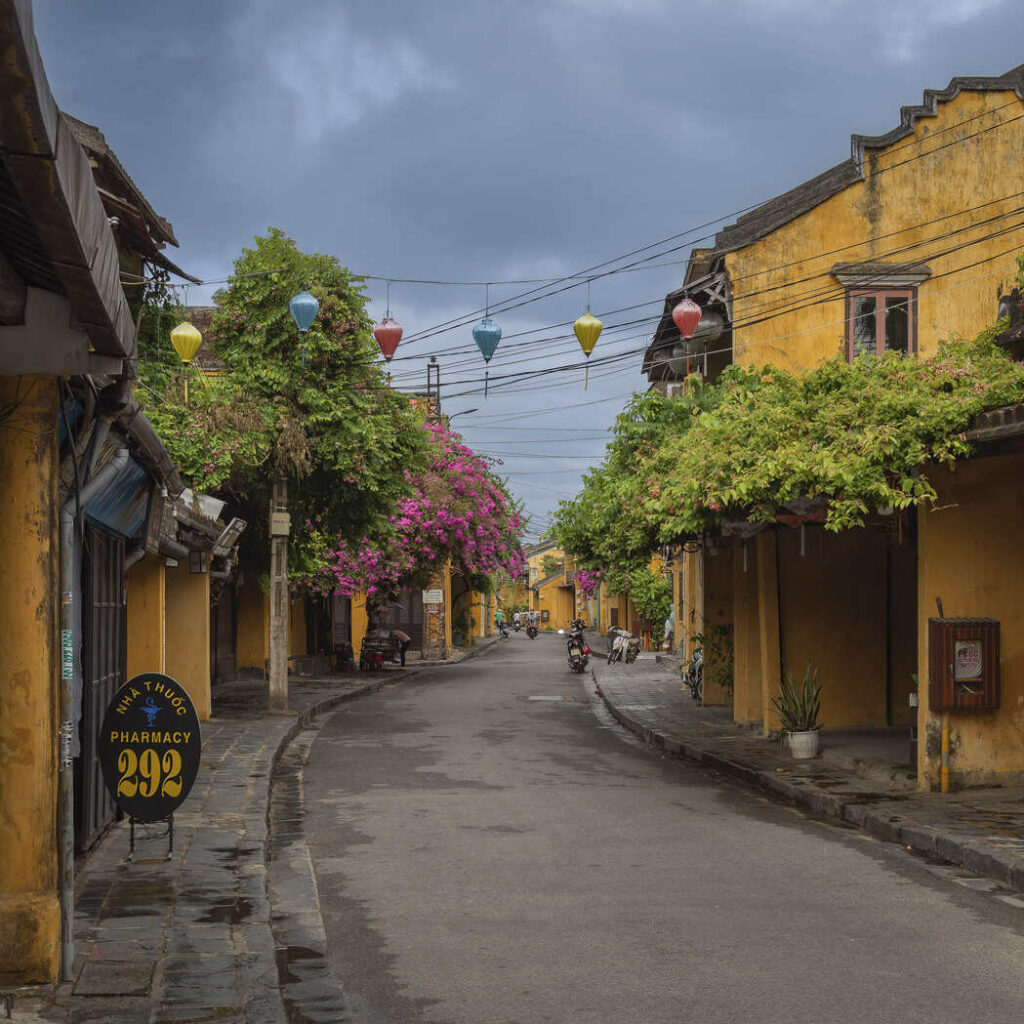
Getting Tickets
Technically to just enter Hoi An Ancient Town you need to buy tickets. Fear not, it is rarely policed but if challenged, just buy them. You will need tickets anyway to enter the listed heritage sites described below and that is well worth the effort.
There are ticket offices with English-speaking staff at all of the major entryways to Hoi An Ancient Town. Five passes to historic sites come as a batch along with a small map for 120,000 VND (children under 15 free) and guarantee Old Town access for the rest of your stay. But if you want to visit more than five sites you’ll need to buy extra tickets.
If you are not sure about the ticket booths two prominent ones are: 78 Le Loi Street (Hoi An Office of Tourist Services) and by the Lantern Bridge (An Hoi Side).
Motorbikes are not permitted to enter Hoi An Old Town from 9am – 11am / 3pm – 10pm (1 May – 30 Sept) and 9am – 11am / 3pm – 9.30am (1 Oct- 30 April). Bicycles can enter anytime but cars and taxis are banned completely.
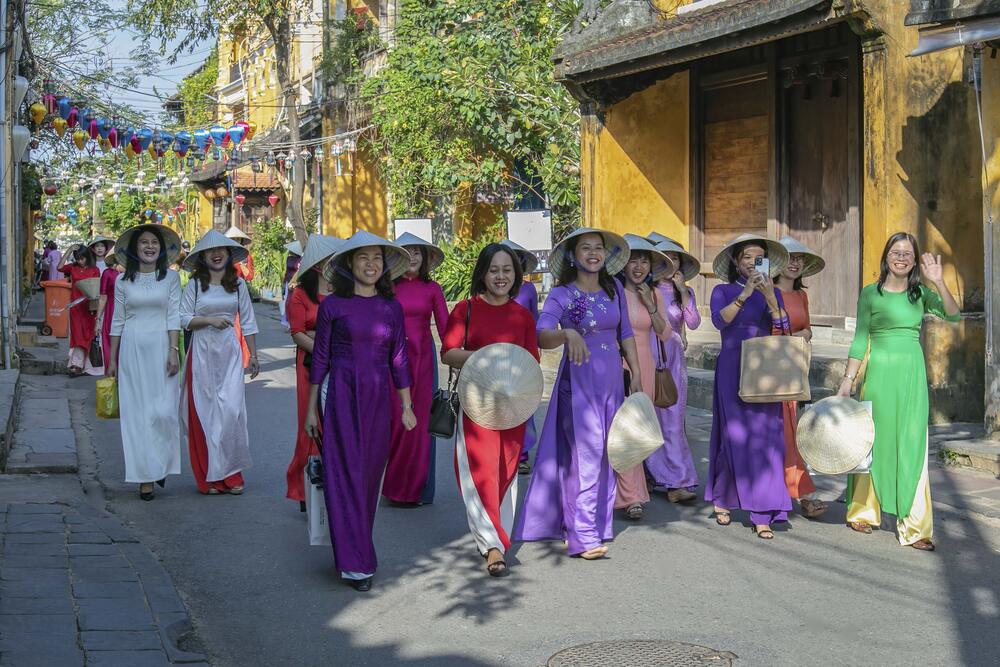
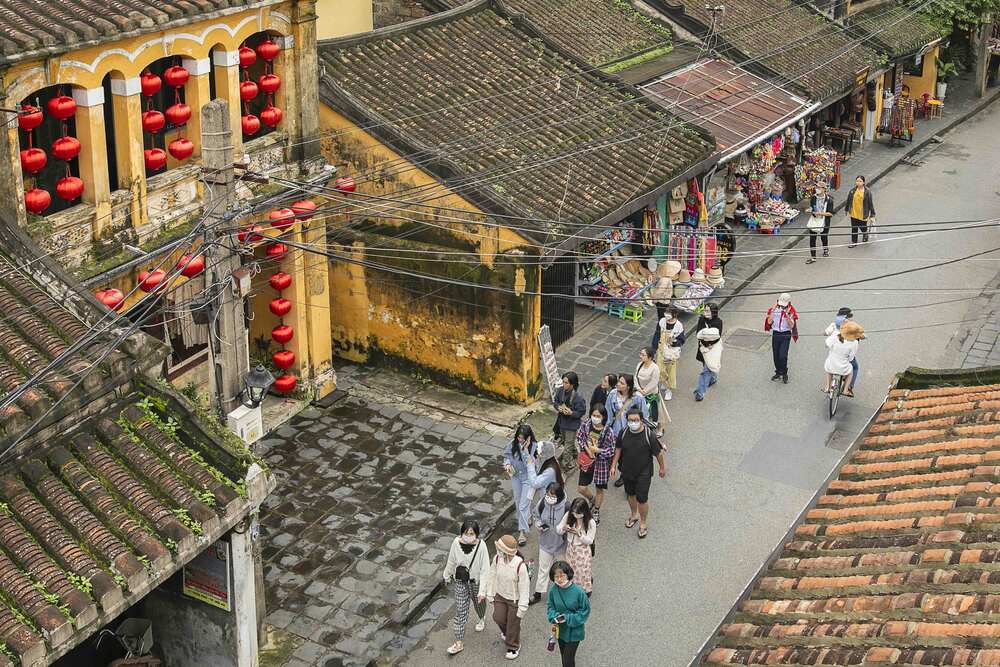
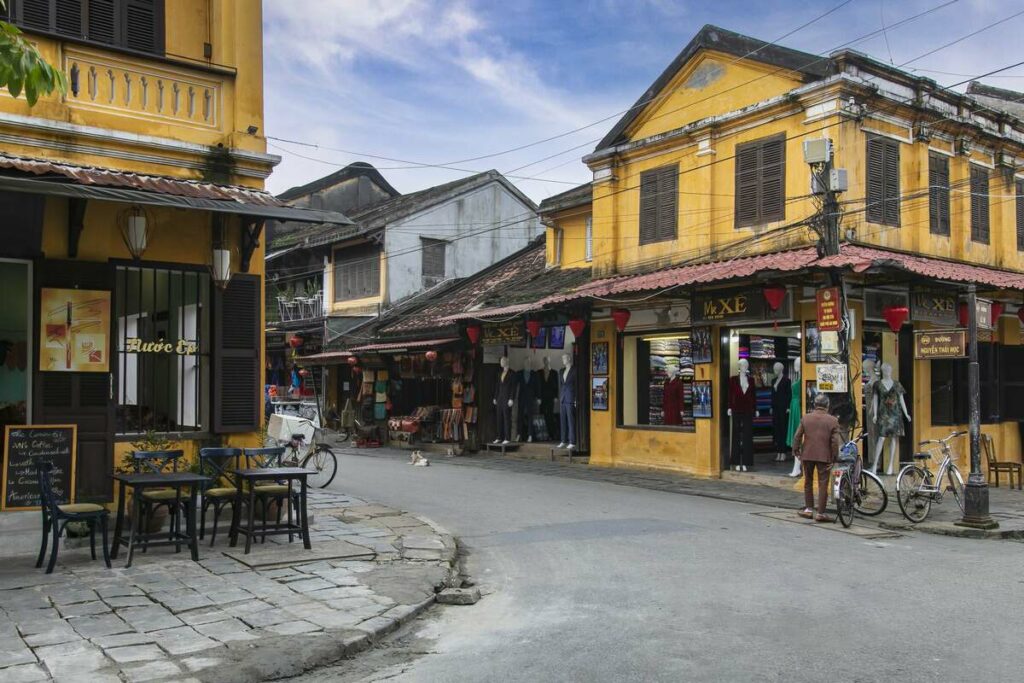
About Hoi An Ancient Town
History – How Old is Hoi An’s Old Town?
For over 1000 years Hoi An was part of the deeply spiritual Champa Kingdom. The Hindu Champas were overthrown by the invading Vietnamese in the 15th century and the city’s Ancient Town was established as a major trading port around the time of their defeat in 1471.
Hoi An would then have featured on the infamous silk road, running from China and Japan, and looking at the network of rivers running through the city it’s easy to see why!
Japanese and Chinese Traders
First came Japanese traders who were soon followed by the Chinese. After Japan banned contact with foreigners during the 1630s the Chinese traders became the dominant group. The first Chinese assembly halls were built in the mid-1700s. After 1858 a number of French Colonial buildings were added to the mix.
Hoi An Ancient Town Architecture
The majority of the buildings were built between the 15th and 19th centuries. Hoi An Ancient Town is a stunning example of architectural influences brought by fishermen, traders and colonialists. Walking around the Old Town you’ll see Chinese, Japanese, Portuguese, Vietnamese and French traits in the various buildings.
UNESCO World Heritage Status
When Hoi An earned UNESCO World Heritage Site status in 1999 UNESCO stated: (Hoi An’s) buildings and its street plan reflect the influences, both indigenous and foreign, that have combined to produce this unique heritage site.
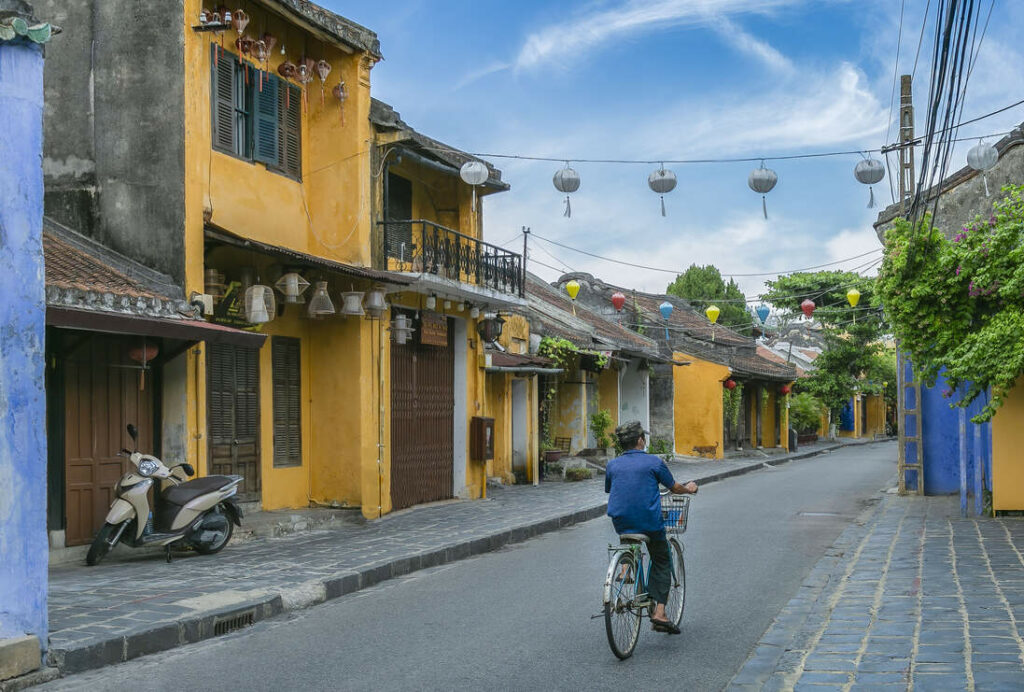
What To See in Hoi An Old Town
UNESCO World Heritage Site
Hoi An Ancient Town is a UNESCO heritage site for good reason. Its architecture and original street plan make for a stunning walking or cycling experience. A melting-pot past is reflected in many different building styles in the Old Town.
The Old Town of Hoi An is symbolically represented by the iconic Japanese Covered Bridge but the entire site is a living treasure.
On Bach Dang Street you’ll find the poetic Thu Bon River peppered with little rustic boats and colorful lanterns edged by a variety of charming restaurants, cafes, shops and stalls. This is also where you’ll find Hoi An’s extensive Central Market.
Make sure you go for an afternoon wander along the ‘walking’ streets – Tran Phu, Nguyen Thai Hoc and Le Loi – and narrow lanes at some point during your stay. Drop by early in the morning (around 6am) to skip the hustle and bustle and steady stream of tourists if you visit during high season.
Shopping in Hoi An Ancient Town
Hoi An boasts many heritage sites of Chinese, Japanese and Vietnamese origin but these days it’s primarily a retail and cafe environment in the quaintest possible ‘ancient’ setting imaginable with 19th century structures commonly hosting tailors, coffee shops, clothing stores and gift vendors.
Tran Phu Street, Nguyen Thai Hoc Street and Le Loi Street host most retailers but you never know what you might find if you go exploring down myriad narrow lanes. It’s also worth noting the ‘Japanese side’ of the Japanese Covered Bridge has a slightly different, quieter and more arty feel.
Tailors
Hoi An is famous for its bespoke tailors. Dresses, suits, shirts and pants can be had in a couple of days involving two fittings. And at a fraction of the price paid in Western countries. There are hundreds of options so it pays to do your research before jumping in the deep end.

Clothes, Shoes and Accessories
Clothes shops range from homegrown and expat designers with original selections to touristy T-shirt outlets and much else in between. Like its tailor shops, Hoi An Ancient Town’s leather shops are keenly sought for quality goods, especially bags, at much cheaper prices than in the West. Abundant shoe shops offer ready-to-wear and bespoke footwear as well. Again it pays to do a little research as the options are overwhelming.
Markets
On the edge of Hoi An Ancient Town is the Central Market which includes a Cloth Market, and countless stalls selling everything under the sun. From souvenirs for your loved ones back home and bamboo kitchen utensils for yourself, to fresh fruits and vegetables, kids toys, shoes, clothes, bags, jewelry and luggage you can find anything and everything at the Central Market in Hoi An. There’s a food hall too.
Arts, Gifts and Souvenirs
You can find jewelry, local artefact vendors, souvenir stores and art shops and galleries in Hoi An Ancient Town sprinkled through the rest.
Great gift ideas that reflect Vietnamese culture include Ao Dai (the national costume of Vietnam), conical hats (the symbol of Vietnamese agriculture) and traditional, hand-crafted ceramics.
You’ll also find traditional Vietnamese textiles, made-in-China trinkets, and artificially aged ‘antiques’.
As well as the standard gift shops there are many art galleries in Hoi An. Mass produced paintings for the tourist market dominate but there are some real gems to be found by those who take their time.
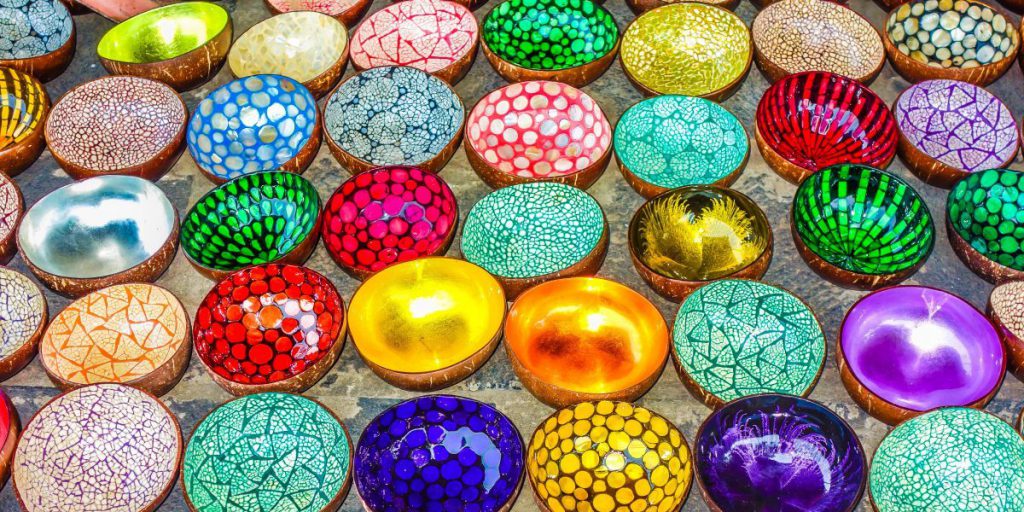
Cafes in Hoi An Ancient Town
Coffee is a big deal in Vietnam, as is cafe culture. Hoi An Ancient Town showcases this in spades, the aroma of freshly-ground coffee beans beckoning around every corner.
Hoi An Ancient town coffee shops offer an array of fascinating settings from leafy courtyards to traditional tea houses to rooftop locations full of style and old-world charm, perfect for a break from your meanders.
Restaurants and Bars in Hoi An Ancient Town
Restaurants and bars make up most of the rest. Especially after dark, a fairytale mood prevails with thousands of lanterns of every hue lining the alleyways and streets luring masses of awestruck visitors.
Hoi An Ancient Town hosts many international cuisines – Greek, Italian, Japanese, Fusion and French sit shoulder to shoulder with traditional Vietnamese eateries from street food specialists to fine dining. And the Indian eateries and much more sit just a block away in Phan Chu Trinh Street.
Some of the restaurants double up as wine bars complete with Happy Hours and a few dedicated bars, like the Dive Bar, can be found but for any action after 10pm you’ll need to head to An Hoi Islet across the Lantern Bridge.
The Thu Bon River
Day or night it’s great to hire a boat for 30 minutes or more and take in Hoi An Ancient Town’s glory from the water. When the town’s in flood you can actually boat up and down the streets! Another relaxing option is to hire a cyclo and check out what’s on offer at close quarters from the comfort of your pedal-powered cabin.
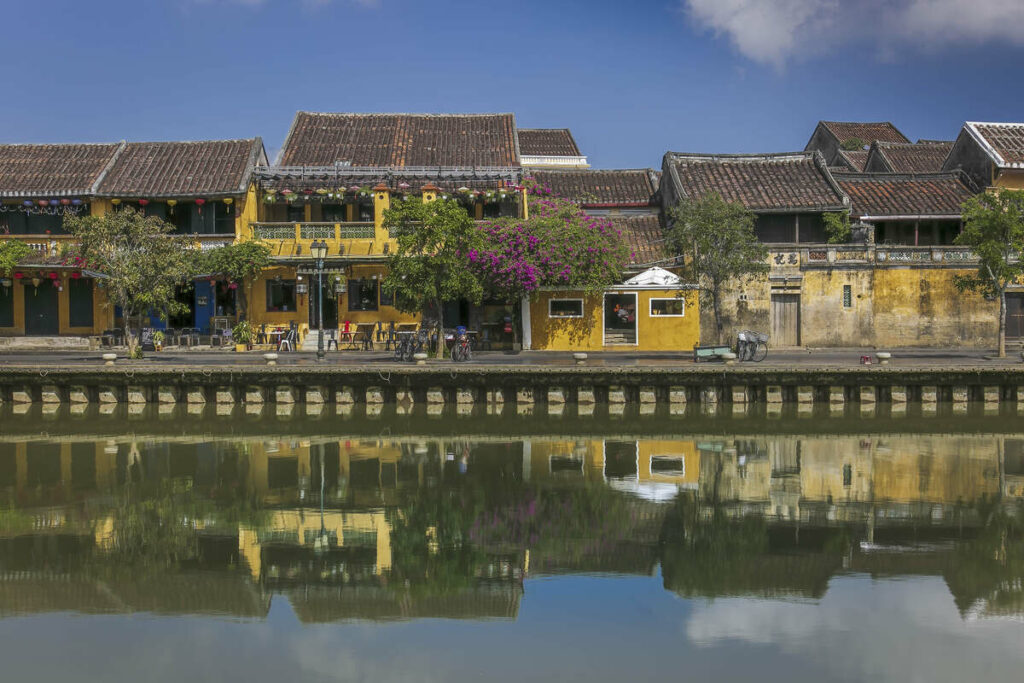
An Hoi Islet
Although strictly speaking not part of Hoi An Ancient town, An Hoi Islet has been included in the motorbike free zone along Nguyen Phuc Chu Street which looks across the Thu Bon River back to Hoi An Ancient Town. Access to An Hoi Islet is via the Lantern Bridge near where Bach Dang and Nguyen Thai Hoc Streets intersect.
This area does have a few important retailers but it’s more renowned for its restaurants, hotels, bars and cafes. This is where you’ll find iconic restaurants such as Mango Mango and some of Miss Vy’s restaurant empire. Also, If you are looking for action after most venues have closed, An Hoi is the place to go.
You can also find the Hoi An Night Market on An Hoi Islet not far from the Lantern Bridge.
Things to do in Hoi An Ancient Town
Japanese Covered Bridge
The Japanese Covered Bridge is a great place to begin your exploration of Hoi An Ancient Town. Constructed in the 1590s, it was originally built to link the Japanese and Chinese quarters of this once thriving merchant town. This iconic landmark is Hoi An’s most famous and, if visiting at night, keep an eye out for couples in traditional clothing posing for photos – don’t be shy about snapping a pic of them beside this brightly-lit, scenic backdrop. The bridge is guarded by a pair of dogs on the Chinese side and by monkeys on the other.

Hoi An Ancient Town Heritage Sites
Chinese Assembly Halls
For most the Chinese Assembly Halls are the outstanding historical and cultural sites in Hoi An Ancient Town. Part temple and part meeting place, the best of them also feature extensive grounds impressively displaying the polytheism and mythological creatures of ancient Chinese tradition.
The standout Chinese Assembly Halls are the Fujian and Cantonese Halls but they’re all worth a visit. If you start at the Japanese Bridge and work your way down Tran Phu you can gather them all in in a gentle stroll. For those interested in multinational splendor of the flourishing, medieval port of Hoi An and the pivotal role of China’s southern, maritime provinces see Chinese Assembly Halls in Hoi An’s Ancient Town for a complete guide.
Quan Cong Temple and its adjacent pagoda (founded 1653) is only a short walk from Phuc Kien Assembly Hall and should be included in all itineraries. Dedicated to the Chinese General Quan Cong – a symbol of loyalty – it includes life-size statues of the general’s horses Bach tho (white horse) and Xich tho (red horse). The most minute details of the temple/pagoda complex have significance, from the calligraphy poems adorning its wooden beams to the carp-shaped rain spouts on the roof that are symbolic of patience.
Of the many things to do in Hoi An, the Chinese Assembly Halls sit above the pack. And your entry ticket allows you to take two days over your 5 prospective visits so you don’t have to cram the visits all in one day.

Old Houses
Visiting an ‘old house’ is one of the options on your entry ticket to Hoi An Ancient Town. Five of these heritage sites have been restored to their original state internally and are available for inspection.
Duc An House and Tan Ky House are the most popular. Unfortunately in all cases, while there is plenty of potential interest, there is little in the way of historical explanation or context to help visitors.
The Old Houses feel cramped and one feels part of an invisible conveyor belt of tourists shuffling through them in a steady stream during high season. Tan Ky House, a fascinating fusion of Japanese and Chinese, is the pick of the crop. Go early to avoid the crush.
Museums
Several museums are also on the official heritage ticketed list. Specialists and enthusiasts aside, these tend to be a little disappointing. The Hoi An museums are: the Museum of Trade Ceramics, Hoi An; the Museum of Sa Huynh Culture; and the Museum of Folk Culture. For non-specialists the Museum of Folk Culture is the most visually impactive reflecting local life in costume, tools and artefacts. Most find the Chinese Assembly Halls more rewarding.
Full Moon Lantern Festival
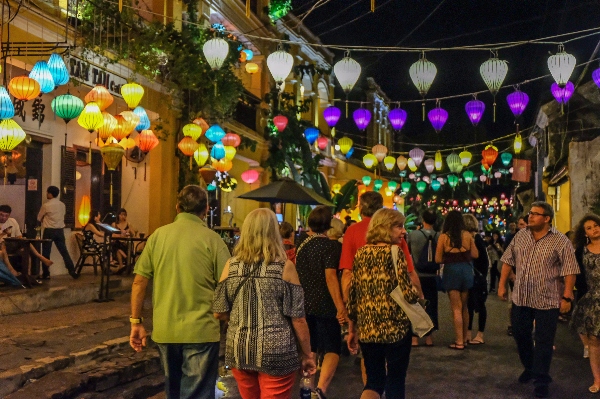
If you want an extra special night in Hoi An Old Town, try and visit during the Hoi An Full Moon Lantern Festival which occurs every month on the 14th day of the Lunar calendar. For the Vietnamese this is a time to pay respects to ancestors by burning fake money and making offerings of fruit and flowers in return for good luck, health and wealth. For tourists it’s a trip back in time, a night when Hoi An Old Town shuts down the lights and lanterns and shimmering candlelight takes over.
Hundreds of ‘candle boats’ are launched onto the Thu Bon River providing a mystical, flickering spectacle as they drift downstream and large crowds gather in a peaceful vigil, touts aside.
Frequently Asked Questions
-
What is special about Hoi An Ancient Town?
Compared to Ho Chi Minh City, Ha Noi or Da Nang, Hoi An is a small town experience but one with plenty to offer. The Ancient Town is a marvel as described above and it’s not just because of a few sites like the iconic Japanese Covered Bridge. Walking through Hoi An Old Town is a blast in countless ways, especially if you explore the lanes as well as the main thoroughfares. There’s something of interest wherever you turn. Hoi An also has some of the world’s best beaches just a few kilometers from Hoi An Ancient Town. The landscape in Hoi An switches from the Ancient Town to urban to rural to fishing village in the blink of eye. Heaps to see, abundant facilities but not big, sprawling or bustling.
-
Which is better Hoi An or Da Nang?
Some people stay in Da Nang and just visit Hoi An for the day. We think they have the balance round the wrong way. It’s better to set up base in Hoi An and make day trips to Da Nang and its attractions. It’s true if you’re seeking spritely nightlife or large supermarkets and the standard features offered by large cities Da Nang will suit you better. But as a cultural experience Hoi An wins hands down and its best absorbed if you stay there. It also provides an opportunity to unwind away from crowds if you want to. Both have great beaches, but Hoi An’s An Bang Beach is hard to beat for waterside facilities. And only Hoi An has been granted heritage status by UNESCO!
-
Does Hoi An have an airport?
No, you must fly into Da Nang but it’s only 30-40 minutes away by car from Da Nang airport.
-
What area is best to stay in Hoi An?
It’s horses for courses. If you want mainly to shop and visit the Ancient Town then stay near there or in Cam Chau (for better prices). If the beach is your thing, look at options at An Bang and Cua Dai beaches. Meanwhile bucolic retreats can be had in homestays in Cam Thanh.
-
How many days do you need in Hoi An?
If you’re on the move and visiting many parts of Vietnam we recommend at least three days. But many make Hoi An their base and settle right in for their complete stay. Countless times visitors have told us they wished they’d allowed more time for Hoi An instead of the standard 2-3 days.
-
How do I get from Da Nang to Hoi An?
See Hoi An to Da Nang Airport for everything you need to know. The travel links remain the same, just reverse the process. By far the best method is to book a private car which will cost just a little over 10USD one way and a little more for a seven seat vehicle (recommended if you have substantial luggage).
-
Does Hoi An flood every year?
Yes it does flood most years during the rainy season (September to December) for a few days here and there, but you can never be sure exactly when. It’s all part of the adventure of visiting Hoi An. When flooded, the Old Town becomes Venice-like and enterprising locals offer boat trips through the streets.
-
How much is a taxi from Da Nang to Hoi An?
A taxi from Da Nang to Hoi An is likely to be over 20USD and a Grab something similar. As you can book a private car for half the price, and the price is fixed, that method is recommended. See Hoi An to Da Nang Airport.
-
Does Hoi An have nice beaches? How far is the beach from Hoi An?
Hoi An has fabulous beaches and they are only a few kilometers from the center. Cua Dai Beach and An Bang Beach also have many hotels and homestays.
-
What is the best time of year to visit Hoi An?
If you want to steer clear on the wet season (September-December) and the height of summer when it’s super hot in the high 30s (June-August) you should look at February to May when its still plenty warm enough for the beach but not as enervating as the ‘summer’ months.
